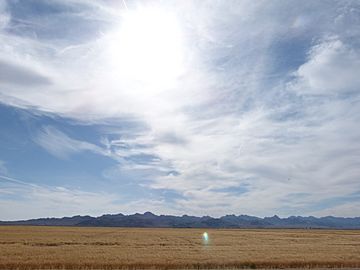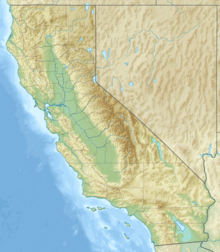Big Maria Mountains facts for kids
Quick facts for kids Big Maria Mountains |
|
|---|---|

A view of the Big Maria Mountains from the Parker Valley
|
|
| Highest point | |
| Elevation | 1,031 m (3,383 ft) |
| Geography | |
| Country | United States |
| State | California |
| District | Riverside County |
| Range coordinates | 33°51′0″N 114°42′3″W / 33.85000°N 114.70083°W |
| Topo map | USGS Big Maria Mountains SW |
The Big Maria Mountains are a mountain range in the southeastern part of California, a state in the United States. They are located close to the Colorado River and the state of Arizona. You can find these mountains between the towns of Blythe and Vidal.
The mountains are west of U.S. Route 95 in California and east of Midland. The highest point in the range is about 1,030 meters (3,379 feet) tall. A power line that connects Parker Dam to Yuma, Arizona also runs through these mountains. A smaller mountain range, called the Little Maria Mountains, is located just to the west.
Contents
How the Mountains Were Formed
The Big Maria Mountains are part of a larger group of mountains called the Maria fold and thrust belt. Millions of years ago, during the Cretaceous Period, the Earth's crust in this area was squeezed together. This squeezing caused the rocks to fold and push upwards, creating the mountains.
Later, during the Miocene Epoch, the Earth's crust started to pull apart. This pulling apart stretched the land and exposed the older folded rocks. This process helped shape the mountains we see today.
Plants and Animals
The Big Maria Mountains are home to many interesting plants and animals. You can find different types of cacti here, like the foxtail cactus (Escobaria vivipara subsp.) and the California barrel cactus (Ferocactus cylindraceus). These plants are well-adapted to the desert environment.
A special group of Burro mule deer (Odocoileus hemionus var. eremicus) also lives in these mountains. They depend on the nearby Colorado River for their water and survival.
Big Maria Mountains Wilderness Area
A large part of the Big Maria Mountains is protected as a wilderness area. This area is managed by the Bureau of Land Management. It is a special place for people to enjoy nature and for wildlife to live safely.
The land in the wilderness area changes a lot. You can see gently sloping areas called Alluvial fans, which are like natural ramps made of rock and dirt. There are also many rough, rocky peaks and deep, steep canyons. The wilderness area is a great place for hiking and exploring the desert landscape.
Rice Valley Wilderness
The Bureau of Land Management also takes care of another protected area nearby, called the Rice Valley Wilderness. This wilderness includes the wide, flat plains of Rice Valley and the northwestern part of the Big Maria Mountains.
In the middle of Rice Valley, you can find small dunes that are about 30 to 40 feet tall. This valley is part of a very large area of sand that stretches across the desert. The Big Maria Mountains rise high above the valley, reaching elevations of 2,000 feet in this area.


